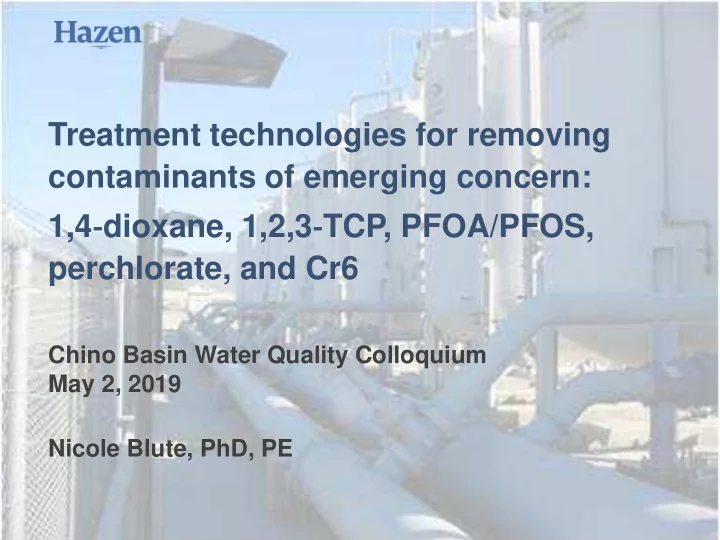

Treatment technologies for removing contaminants of emerging concern: 1,4 ‐ dioxane, 1,2,3 ‐ TCP, PFOA/PFOS, perchlorate, and Cr6 Chino Basin Water Quality Colloquium May 2, 2019 Nicole Blute, PhD, PE
Agenda • Review emerging contaminants of concern in the Chino Basin • Present treatment options • Discuss factors affecting treatment selection and design
1,4-Dioxane Background Sources Used as a solvent and stabilizer in the past Chemical Highly soluble in water resulting in Characteristics significant groundwater transport Low adsorbability to carbon Relatively resistant to biological treatment options California Notification Levels: PFOA – 14 ug/L, PFOS – 13 ug/L
1,4-Dioxane AOP Treatment UV light reacts with an oxidant (peroxide, ozone, hypochlorite) for form hydroxyl radicals (•OH) •OH radicals are highly reactive, including with organic constituents of concern
1,4-Dioxane AOP Treatment Key Design Parameters • Elevated nitrate levels can result in scavenging and production of nitrite for medium pressure UV • TOC and UV transmissivity are key • Buffer capacity of water typically makes UV/chlorine more costly unless treating RO permeate • Residual peroxide quenching (GAC or chlorine) Cl 2 + H 2 O 2 → O 2 + 2 HCl Approximately 2:1 Cl 2 : H 2 O 2
1,4-Dioxane Emerging Technology - Resin Ion Exchange with Regeneration • Industrial applications, fairly small scale (100-200 gpm) • Requires steam regeneration of resin on site
PFOA/PFOS Background Sources Anthropogenic compounds used in many consumer products (Teflon, Scotchgard, Gore-tex), fire fighting foams Mobile in water Chemical Characteristics Very persistent in the environment (high solubility, low volatility High adsorbability to carbon for long chains; less for short chains Biological degradation minimal California Notification Levels: PFOA – 14 ng/L, PFOS – 13 ng/L
Treatment Options for PFOS and PFOA RO NF $$ • 90% removal Effectiveness of GAC treatment depends • >90% removal on concentration, raw water quality, Anion Exchange and other • 10->90% removal, depending on water quality variables Advanced Oxidation X • Not effective
PFOA/PFOS GAC Treatment Key Design Parameters • GAC is effective for longer-chain molecules • Removal to non-detect levels may require polishing step – e.g., GAC or IX Ref: Sun et al., 2016
PFOA/PFOS Persistence
1,2,3 – Trichloropropane Background Sources Primarily from an impurity in fumigants Also reported to be an anthropogenic compound associated with degreasing and cleaning agents Mobile in water Chemical Characteristics Persistent in the environment (high solubility, low volatility) No federal MCL, but California has an MCL of 5 ng/L
1,2,3-TCP GAC Treatment • GAC listed by DDW as the only best available technology • Commonly lead-lag configuration to maximized carbon utilization • GAC removes 1,2,3-TCP to less than the DLR
1,2,3-TCP Emerging Technology – Biological Treatment Carollo, 2016.
Chromium Background Naturally occurring from minerals Sources Anthropogenic Inorganic anion Chemical Characteristics Cr6 primary aqueous species; Cr3 forms precipitate Persistent in the environment (high solubility, low volatility) Biological degradation is possible Former Cr6 MCL of 10 ug/L; new MCL expected.
Chromium Treatment Best Available Technologies Weak-Base Strong-Base Anion Anion Exchange Exchange (WBA) (SBA) Reduction Coagulation Reverse Filtration Osmosis (RCF or (RO) RCMF)
Alternate Technology – Stannous Chloride • Salt made of tin and chloride (SnCl 2 ) • No regulatory guidance on tin • Reduces Cr(VI) to Cr(III) and forms a precipitate that can be filtered • Could be used with filtration similar to iron in RCF process • Concern about long term fate of tin and chromium particles in the distribution system – more study is needed
Alternate Cr6 (and nitrate, perchlorate, and VOC) Technology – Biological Treatment LA County District Well 37-01 WQTS, 2014. WRF 4470.
Alternate Cr6 Technology – Biological Treatment WQTS, 2014. WRF 4470.
Perchlorate Background Solid rocket fuels and propellants, Chilean Sources fertilizers, background Inorganic anion Chemical Characteristics Persistent in the environment (high solubility, low volatility) Low adsorbability to carbon Biological degradation is possible California MCL 6 ug/L; DDW likely to decrease the DLR to determine if regulation to a lower concentration is warranted.
Perchlorate – Ion Exchange Treatment Removal by Ion Exchange Regenerable SBA Perchlorate-Selective Resin
Summary of Treatment Approaches GAC AOP IX RCF Biolog- RO ical ✓ ✓ ✓ 1,4-Dioxane (quench- ing) ✓ ✓ ✓ 1,2,3-TCP ✓ ✓ ✓ PFOA/PFOS ✓ ✓ ✓ Perchlorate ✓ ✓ ✓ ✓ Cr6 BAT or leading technology Can be effective but not BAT
Many Roads Lead to GAC… 1,2,3-TCP PFOA/PFOS GAC 1,4-Dioxane (peroxide quenching)
GAC Operations Needs to Consider Nitrate 12 Options: 1 hr shutdown 16 hr shutdown • 10 Online analyzer 48 hr shutdown with filter-to-waste 61 hr shutdown Nitrate (mg/L as N) 8 or blending • 6 Minimize down time 4 • IX downstream of 2 GAC if necessary 0 0 200 400 600 800 Time after Startup (minutes)
Questions? Nicole Blute 310-266-6212 nblute@hazenandsawyer.com
Recommend
More recommend